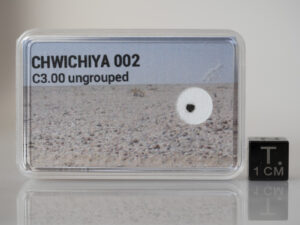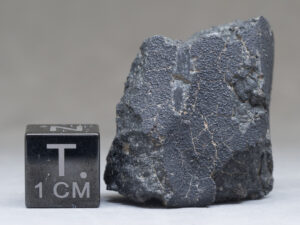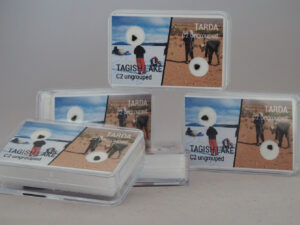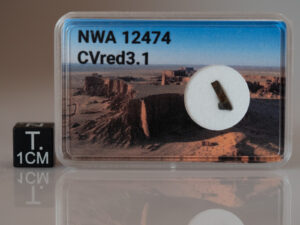Description
This is only CVred 3.1 meteorite !
The meteorite is less metamorphosed than Leoville and Kaba (see Bonal et al., 2020), potentially making it among the most primitive CVs currently known.
Writeup from MB 113:
Northwest Africa 12474, reclassification
Additional data (J. Gattacceca, L. Krämer-Ruggiu, CEREGE; T. Prestard, IPAG): Contains mm-sized CAIs. Opaque minerals are FeNi metal to 100 µm, magnetite to several hundreds µm, and troilite, found both in chondrules and in the matrix. Vis-IR spectra of EATG-leached powder reveal the presence of hydrated silicates, although probably of very low abundance. X-ray diffraction analyses over a ~2 cm2 area on a polished section (D. Borschnek, CEREGE) does not reveal the presence of hydrous phases (serpentine, tochilinite) typically observed in type 2 chondrites using the same experimental setup. Olivine Fa4.59±9.61, median Fa2.55, PMD=117%, range 0.5-48.2 (n=26), Cr2O3 in ferroan olivine (Fa>1) is 0.35±0.23 (n=23). Low-Ca pyroxene Fs3.83±2.78Wo1.29±0.93, range Fs1.1-12.1 (n=19). Oxygen isotopic composition (J. Gattacceca. C. Sonzogni. CEREGE) from analysis of one 2 mg aliquot of a powdered 411 mg bulk sample is δ17O=-4.34‰, δ18O= 0.34‰, Δ17O=-4.51‰ (slope 0.52, analytical uncertainties 0.08‰. 0.12‰. 0.03‰ respectively).
NWA 12474 is a carbonaceous chondrite (CVred3.1). Subtype based on Raman spectroscopy of the matrix. The meteorite is less metamorphosed than Leoville and Kaba (see Bonal et al., 2020), potentially making it among the most primitive CVs currently known.
Writeup from MB 108:
Northwest Africa 12474 (NWA 12474)
(Northwest Africa)
Purchased: 2003
Classification: Carbonaceous chondrite (CR3)
Physical characteristics: Dark stone. Cut surface reveals dark interior with chondrules.
Petrography: Chondrite with well-defined chondrules set in an abundant fine-grained matrix (55 vol% from point counting, n=609). Average apparent chondrule diameter 650±310 μm (n=40). Strong weathering. Opaque minerals are FeNi metal, magnetite, troilite, often forming composite opaque grains. The chondrules are layered with metal/sulfide rims; opaques are also found blebs up to 300 µm in size, and some metal blebs occur at the surfaces of chondrules. XRD does not show evidence for the presence of phyllosicates. Based on the structural order of the polyaromatic matter assessed by Raman spectroscopy (L. Bonal, IPAG), this meteorite appears slightly metamorphosed, less than Bishunpur (type 3.1). The Raman spectroscopy parameters of interest are FWHM-D (cm-1)=180.3±8.7, ID/IG=0.96±0.04, N=7 (see Bonal et al. 2016, figure 6). Terrestrial weathering is strong with alteration veins crosscutting the meteorite.
Geochemistry: Olivine Fa1.9±0.8, PMD=35%, Fa0.5-2.9, Cr2O3=0.4±0.2wt%, (n=5). Low-Ca pyroxene Fs2.4±0.7Wo1.2±0.4, range Fs1.3-3.3Wo0.6-1.8 (n=7). Plagioclase An86.4±2.7Ab13.5±2.8.0Or0.0±0.1 (n=2). Magnetic susceptibility log χ (× 10-9 m3/kg) = 4.69.
Classification: CR3. CR group based on petrography (chondrule size, metal abundance), and geochemistry. Type 3 based on the absence of phyllosilicates; subtype is ~3.1 based on Raman spectroscopy .
Specimens: 29 g and a polished section at CEREGE. Main mass with Kuntz.





